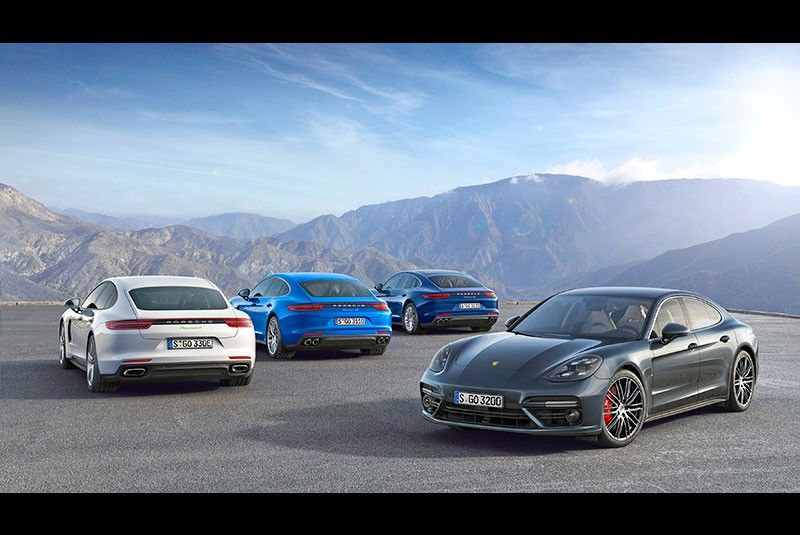The Porsche Panamera—The first true 4-door sports car

MANILA, Philippines - You want the driving dynamics and svelte styling of a luxury sports car but the realities of life (family, parking space, etc.) conspire to keep you from adding that sexy new 911 to your garage. Thankfully, Porsche has the solution.
It’s called the Panamera and, for 2017, it’s become better than ever. Now on it’s second generation, the all-new Panamera spectacularly marries the dynamic performance of a low-slung sports car with the luxury and comfort of a saloon.
Visually, the unique concept of this large Porsche is reflected in a new expressive design with graceful proportions, pronounced shoulders, athletic flanks and an extremely fast roofline. Every design aspect of the iconic 911 is beautifully mirrored in the new Panamera, right down to the voluptuous fender flares that’s best viewed from the rear. The hood, trunk, fenders and roof are now all made from lightweight aluminum.
“Like many car lovers out there, I am immensely elated with the arrival of the all-new Porsche Panamera in the country,” said Porsche Center Philippines head Roberto Coyiuto III. “Measured by whatever yardstick, it’s clearly head and shoulders above the competition in all aspects—reflecting the best of what Porsche is known for.” Coyiuto added that other variants of the Panamera, such as the 4S and V6, will brought into local showrooms as well.
The new Panamera is 5,049 mm (+34 mm) long, 1,937 mm (+6 mm) wide and 1,423 mm (+5 mm) tall. Despite the slight increase in height, the four-door car looks much lower and longer. This is primarily due to the reduced height above the rear of the passenger compartment – reduced by 20 mm – while maintaining consistently good headroom. This changes the car’s overall image completely.
The wheelbase has been increased by 30 mm to 2,950 mm; this too lengthens the car’s proportions. The front wheels were shifted further forward, reducing the front overhang and making the prestige dimension – the distance between the A-pillar and the front axle – even larger. The rear overhang is longer, giving the car a more powerful appearance.
The flared lips of the wheel arches are also powerful. The large arches provide space for the 19-inch (4S/4S Diesel), 20-inch (Turbo) and optional 21-inch alloy wheels.
Integrated seamlessly and elegantly into the power-actuated liftgate is the extendible rear spoiler that is now finished in body color. On the Panamera Turbo, the wing also splits as it extends, thereby gaining additional surface area.
Inside, the typical Porsche interior has been reinterpreted. Black panel surfaces and interactive displays combine a clear and intuitive user interface like that of smartphones and tablets. Touch panels and individually configurable displays take center stage in the new Porsche Advanced Cockpit.
The Porsche Advanced Cockpit transforms the analog world into the digital present while leaving room for passion and heritage. The tachometer, positioned centrally in the instrument cluster, is a tribute to the 1955 Porsche 356 A.
Two 7-inch displays are placed directly in the driver’s line of sight. Located in the middle of these two displays is the analog tachometer. The gearshift console between the driver and front passenger is dominated by a customizable 12.3-inch touchscreen, which integrates online navigation, smartphone integration via Apple Car Play and a new voice control system.
The Panamera offers surprising everyday practicality for a luxury saloon, with a 40:20:40 split of the folding rear backrests (upping trunk space from 495 to 1,304 liters). Raising the comfort experience of the Panamera to an entirely new level are new equipment options such as the panoramic tilt roof, massage seats, ambient lighting and a 3D high-end sound system from Burmester.
All of the new Panamera’s engines (mounted lower in the chassis for a lower center of gravity) have been redesigned—more powerful, while significantly improving fuel economy and reducing emissions. Three new twin-turbo direct-injection engines are being introduced in the Panamera Turbo, the Panamera 4S and the Panamera 4S Diesel.
All of them – and for the first time including the diesel – may be equipped with a permanent all-wheel drive system and a new eight-speed Porsche dual-clutch transmission (PDK). A 4.0-liter petrol V8 that delivers 550hp/770Nm powers the Panamera Turbo and a 2.9-liter petrol V6 with 440hp/550Nm drives the Panamera 4S.
In the Panamera 4S Diesel, a V8 with 422hp generates powerful thrust with an incredible 850Nm of torque.
In keeping with the overall concept of the Panamera, the chassis also unites the cruising comfort of a luxury saloon with the performance of a sports car. This is achieved by using innovative systems such as an adaptive air suspension with new three-chamber technology, including Porsche Active Suspension Management (PASM electronic damper control), the enhanced Porsche Dynamic Chassis Control Sport (PDCC Sport) system including Porsche Torque Vectoring Plus (PTV Plus) and active roll stabilization, as well as a new electromechanical steering system.
The integrated 4D Chassis Control system analyzes and synchronizes all chassis systems in real time and optimizes the car’s performance. Porsche is also taking the steering precision and handling of sports cars into the class of Gran Turismo cars with rear axle steering – which is also new and has been adapted from the 918 Spyder and 911 Turbo.
The Panamera is equipped with many standard and optional assistance systems, which make driving more convenient and safer. The most important new systems include Night Vision, which uses a thermal imaging camera to detect people and large animals and displays a color-highlighted warning indicator in the cockpit. If the optional new LED matrix headlights with 84 image points are selected, people beyond the visual range of the dipped beam headlight are also illuminated briefly if they are in the computed driving corridor, allowing the driver to react even faster.
Looking especially far ahead along the road is the new Porsche InnoDrive, which includes adaptive cruise control. Based on navigation data and signals from radar and video sensors, it computes and activates the optimal acceleration and deceleration rates as well as gear selections and coasting phases, for the next three kilometers. In doing so, this electronic co-pilot automatically takes bends, inclines and speed limits into account.
Engine response can be further increased using the optional Mode Switch with the Sport Response button. The Mode Switch, which was first introduced in the Porsche 918 Spyder, is an intuitively operated rotary ring on the steering wheel, which can be used to activate one of four driving modes (Normal, Sport, Sport Plus or Individual). Located at the center of the switch is the Sport Response button, which can be used to free up the maximum power potential of the Panamera at the press of a button.
The flagship Panamera Turbo accelerates to 100 km/h in 3.8 seconds (3.6 with the Sport Chrono Package) and can reach a top speed of 306 km/h. The Panamera 4S can reach 100 km/h in just 4.4 seconds (4.2 seconds with the Sport Chrono Package), with a top speed of 289 km/h. The 4S and Turbo are also characterized by an exceptionally full-bodied sound.
The most powerful diesel in a Porsche production car yet has a top speed of 285 km/h and reaches the 100 km/h speed mark in 4.5 seconds (4.3 seconds with the Sport Chrono Package).
Powerful. Fast. Beautiful. Luxurious. Practical. Fuel-efficient. Who says you can’t have your cake and eat it, too?
- Latest


























